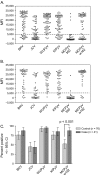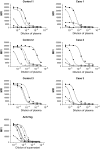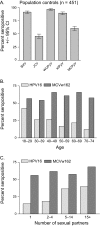Association of Merkel cell polyomavirus-specific antibodies with Merkel cell carcinoma
- PMID: 19776382
- PMCID: PMC2773184
- DOI: 10.1093/jnci/djp332
Association of Merkel cell polyomavirus-specific antibodies with Merkel cell carcinoma
Abstract
Background: Merkel cell polyomavirus (MCPyV) has been detected in approximately 75% of patients with the rare skin cancer Merkel cell carcinoma. We investigated the prevalence of antibodies against MCPyV in the general population and the association between these antibodies and Merkel cell carcinoma.
Methods: Multiplex antibody-binding assays were used to assess levels of antibodies against polyomaviruses in plasma. MCPyV VP1 antibody levels were determined in plasma from 41 patients with Merkel cell carcinoma and 76 matched control subjects. MCPyV DNA was detected in tumor tissue specimens by quantitative polymerase chain reaction. Seroprevalence of polyomavirus-specific antibodies was determined in 451 control subjects. MCPyV strain-specific antibody recognition was investigated by replacing coding sequences from MCPyV strain 350 with those from MCPyV strain w162.
Results: We found that 36 (88%) of 41 patients with Merkel cell carcinoma carried antibodies against VP1 from MCPyV w162 compared with 40 (53%) of the 76 control subjects (odds ratio adjusted for age and sex = 6.6, 95% confidence interval [CI] = 2.3 to 18.8). MCPyV DNA was detectable in 24 (77%) of the 31 Merkel cell carcinoma tumors available, with 22 (92%) of these 24 patients also carrying antibodies against MCPyV. Among 451 control subjects from the general population, prevalence of antibodies against human polyomaviruses was 92% (95% CI = 89% to 94%) for BK virus, 45% (95% CI = 40% to 50%) for JC virus, 98% (95% CI = 96% to 99%) for WU polyomavirus, 90% (95% CI = 87% to 93%) for KI polyomavirus, and 59% (95% CI = 55% to 64%) for MCPyV. Few case patients had reactivity against MCPyV strain 350; however, indistinguishable reactivities were found with VP1 from strain 350 carrying a double mutation (residues 288 and 316) and VP1 from strain w162.
Conclusion: Infection with MCPyV is common in the general population. MCPyV, but not other human polyomaviruses, appears to be associated with Merkel cell carcinoma.
Figures







References
Publication types
MeSH terms
Substances
Grants and funding
LinkOut - more resources
Full Text Sources
Other Literature Sources
Medical

